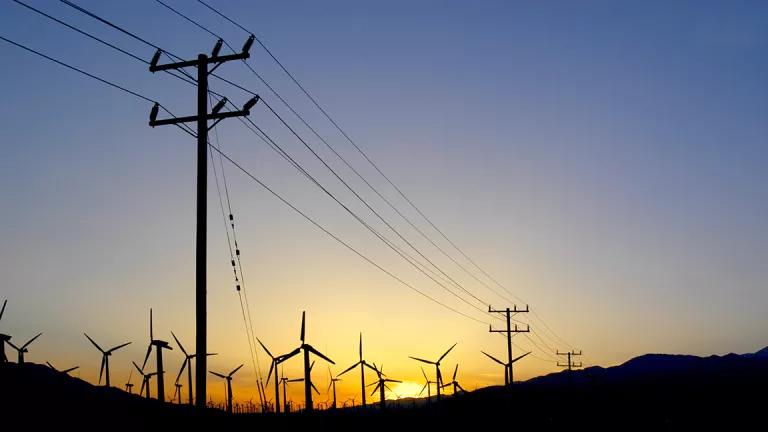Getting Federal Energy Permitting Right
The Biden administration’s plan for a modern review and approval process would go a long way toward fixing a flawed system. Here’s what it will take to get this right.

Gunther Fraulob/Getty Images
This week, the Biden administration rolled out its blueprint for a modern federal review and approval process to support the clean energy build-out at the pace and scale required to confront the crosscutting crises of climate change, ecological peril, and environmental injustice.
It starts with engaging the communities most directly impacted by clean energy facilities and the transmission grid they require, to make sure the values and interests of frontline communities are respected and that they share in the benefits—both economic and environmental —of the projects they host.
Beyond that, projects must be sited where they belong; federal agencies must have the resources to conduct effective and timely review; woefully outdated mining laws must be updated; and federal authority must align with the national interest in constructing the long-distance, interstate transmission lines needed to connect wind and solar power to a reliable grid.
The administration’s plan, properly implemented, would go a long way toward fixing a flawed and inefficient system. As that happens, it’s important that we avoid mistakes that do more harm than good. Here’s what it will take to get this right.
The plan contains a lot of good proposals that should be implemented
The administration’s road map, which includes both executive actions and proposals to Congress, contains many proposals that align with these necessary improvements. Appropriately, accelerating deployment of critical transmission is at the top of the list. The road map calls on Congress to expedite the connection of interstate and offshore electric transmission lines by providing for electric transmission siting and cost allocation, reforming the interconnection queue process to ensure that clean energy projects can connect to the grid faster, and accelerating deployment of grid-enhancing technologies and transmission line ratings to improve the efficiency of our existing grid. Importantly, the administration announced that key federal agencies have signed a Memoranda of Understanding (MOU) that uses existing authorities to aggressively move major transmission lines forward.
The administration also appropriately recognizes that to support the clean energy build-out at the pace and scale required, we must improve engagement with the communities that host clean energy projects and ensure that they share in the economic and environmental benefits such projects bring. To this end, the road map calls for the creation of community funds to provide grants to stakeholders to enable them to engage on specific federal actions that may affect them, and it requires federal agencies to identify staff to oversee community participation in permitting processes.
The administration has embraced a core concept of “smart from the start” planning, particularly the use of programmatic environmental impact statements (EISs) to accelerate the building of renewable energy projects on federal lands. This sort of landscape-scale planning and zoning is critical for successful directed development. While we agree with the administration’s call for Congress to set new and higher renewable energy development goals on federal land for 2030 and 2035 and to establish renewable energy zones, the administration goes too far in suggesting that projects within these zones should get free passes, known as categorical exclusions. Such exclusions would cut short important community engagement and consideration of new information or changing conditions that are often crucial to a project’s acceptance and support within host communities. This is a tool that has been abused by the oil and gas industry, and the renewable industry shouldn’t follow in these footsteps.
There’s a lot more in the road map that we like as well: incentives for standardization of state and local permits; filling the gaps in the permitting workforce; enhanced data collection; and updating the mining law of 1872. Of course, with all of these provisions, the devil will be in the details.
Several proposals deserve a closer look before they move forward
If Biden’s road map is really going to be cleaner, then it cannot prolong our use of dirty fossil fuels—so, we must be cautious about deploying hydrogen and carbon dioxide infrastructure without proper guardrails. Without sufficient scrutiny and robust community engagement, these technologies could lead to additional carbon pollution; prolonged use of oil, gas, and coal; and negative impacts to communities already burdened by environmental harms.
Senator Manchin’s permitting bill is a nonstarter
NRDC remains staunchly opposed to Senator Joe Manchin’s permitting legislation, particularly his proposal to automatically approve the badly flawed and uniquely risky Mountain Valley fossil gas pipeline (MVP), despite it having been rejected by the courts and the communities that would have to live with it in their backyard. At the rollout event for the blueprint, White House Senior Advisor John Podesta didn’t specifically endorse the MVP, but he mentioned that in the spirit of compromise, President Biden endorsed Manchin’s bill, even though the administration didn’t agree with everything in it. This is deeply disappointing.
Additionally, compromise needs to go both ways. We won’t build the clean energy economy of the future by doubling down on the dirty fuels of the past. NRDC will be working to ensure that Congress embraces the Biden administration’s proposals that result in positive change and rejects those that would strip away essential environmental safeguards, dim the voices of frontline communities, and lock in decades’ more reliance on fossil fuels.



